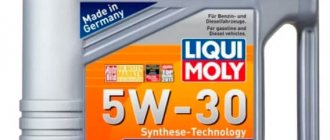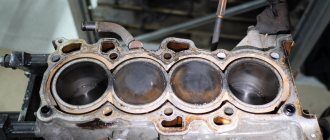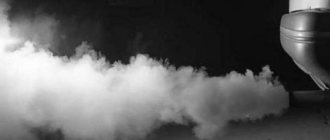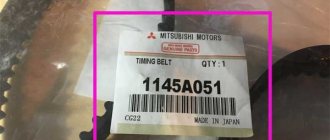In this article we will describe the main characteristics of the Nissan QG16DE engine. It began mass production in 2002, when the power of the vast majority of analogues of the same class did not exceed 100 horsepower. Nissan's new development immediately and without modifications showed a power of 109 horsepower. At that time this was a serious competitive advantage. Over time, the engine showed excellent service life.
Engine characteristics
The abbreviation QG16DE means the following:
- QG – engine series
- 16 – combustion chamber volume, divide it by 10 and get the standard engine volume (1.6 liters)
- D — DOHC gas distribution mechanism (2 camshafts, 4 valves for each cylinder: 2 inlet, 2 exhaust)
- E – type of fuel injection (through injectors)
Let us briefly list the technical characteristics of the QG16DE engine from Yokohama Plant, which has a long service life:
- years of production - 1999 - 2013
- exact volume - 1597 cm3.
- power (hp) – 109 and 118
- torque (N/m) - 144/165
- compression ratio - 9.8
- frequency of lubricant changes - every 7.5-15 thousand km
- permissible oil consumption - up to 0.5 liters per 1,000 km
- engine oil volume - 2.7 l
- environmental class - euro 3/4
- fuel used - gasoline 95
- food - injection
- cast iron cylinder block
- number of cylinders - 4
- valves per cylinder - 4
- piston stroke - 88 mm
- cylinder diameter - 76 mm
- timing drive – chain
approximate resource - more than 350 thousand km.
Cylinder head from block side
Fuel consumption
Let's list the standard gasoline consumption, l/100 km, Nissan Almera Classic 1.6 with 5 manual transmission / Almera Classic 1.6 with 4 automatic transmission / Third generation Primera (P12) with 5 manual transmission:
- city – 9.2 / 10.4 / 9.6
- track – 5.3 / 6 / 6
- mixed cycle - 6.8 / 7.6 / 7.2.
As you can see, the fuel consumption of the Nissan QG16DE engine can be called average.
Where is the engine number?
The engine number is stamped on the right side of the Nissan QG16DE cylinder block. But the metal resource there is limited due to the openness and vulnerability of this point, and the number can quickly be “eaten up” by rust. To prevent this from happening and to be able to see the engine number, you need to protect the marking area with heat-resistant varnish, covering the number several times.
SR20DE
The SR engine series is well known to those who have owned Nissan cars. The engine labeled SR20DE is considered especially popular from this series. They were equipped with almost a dozen different cars produced by Nissan. Its production lasted 12 years and in 2002 it was replaced by a more modern internal combustion engine. Its working volume is 2 liters and it is equipped with distributor fuel injection. Initially, the SR series engine had an aluminum block, the cylinders of which were made of cast iron liners. There is a modification of the engine with single injection - SR20Di. The cylinders in it are bored to 86 mm and this is exactly how the pistons move. The cylinder head is twin-shaft with 4 valves per cylinder. The first version of the SR20DE received a red cover, it features intake ducts, an exhaust system in which the pipe diameter is 45 mm, and camshafts 248 by 240. Later, a version with a black cover and improved environmental performance appeared.
The engine is considered extremely reliable and durable. A very large number of Nissan Primera owners note that if they buy a car, then only with the SR20DE under the hood. The approximate resource is 400,000 kilometers, but this is not the limit. But for a number of reasons, during the operation of a car with such an internal combustion engine, various malfunctions may occur. They are usually associated with a faulty cruise control or mass air flow sensor. Engine oil leaks appear regularly. The first thing you need to look at is the oil pressure sensor and the crankcase oil seal. The timing chain is reliable, runs for 200 thousand km, sometimes more. It is important to monitor its condition; if it stretches or jumps, problems cannot be avoided. This usually happens well after 200 thousand kilometers. Therefore, be careful and listen to the engine. One of the weaknesses of the SR20DE is its vulnerability and sensitivity to engine oil. It is better not to skimp on the quality of the lubricant and purchase technical fluid in accordance with the recommendations given in the car’s operating instructions.
Technical features of the Nissan QG16 engine
The QG16DE motor is a simple and reliable replacement for the GA16DE. It is derated to over 100 hp, its cylinder block is made of high-strength cast iron, and the timing belt is driven by a chain rather than a belt.
The valve timing is varied on the intake shaft, this is a standard CVTC technology.
Variable valve timing clutch
The throttle is electronic, there are no hydraulic compensators. Therefore, it is necessary to periodically adjust the valve clearances with special washers. When it's time to do this, a metallic knock will indicate.
Engine cooling is closed type, antifreeze is preferred. The coolant is driven by an advanced pump specifically designed for the QG16DE.
The ignition system includes an ECU, spark plugs and coils. The latter convert voltage from low voltage to high voltage. The ECU controls the voltage supply to the spark plugs.
Replacing spark plugs with QG16DE
A standard Nissan power system, including an electric fuel pump installed in the gas tank, fuel lines, a fuel pressure regulator, injectors, fuel and air filters, and a throttle valve.
The QG16DE motor is structurally simple, designed with Japanese precision, and therefore reliable.
QG16DE
The development of this engine was carried out by specialists from Aichi Machine Industry. The QG16DE engine was seen as a worthy alternative and replacement for the GA16DE engine. The result is a fairly simple 1.6-liter engine with multipoint fuel injection, a cast-iron cylinder block and an aluminum 16-valve cylinder head. From the in-line 4-cylinder design, it was possible to extract a power of 120 horsepower, which is quite a good indicator, but for a number of reasons, for domestic car enthusiasts, the engine was “strangled” to 110 horsepower. Gas distribution mechanism driven by a chain.
The GA16DE received the usual set of technologies for that time: a variable valve timing system on the intake shaft, a USR valve, an electronic throttle assembly, an intake receiver with swirl flaps. There are no hydraulic compensators - a plus for the simplicity of the design, but you will have to independently adjust the thermal clearances. It is better not to delay this procedure. Adjustable using shims. A specific metallic sound will indicate the need to service the internal combustion engine.
What is the service life of the Nissan Primera 1.6 engine? Focus on 250 thousand kilometers. This is an average. It does not have any serious drawbacks or shortcomings, but in practice there may be some problems with it:
- Dips in traction occur. First of all, look at the timing chain. It can stretch out after 150-180 thousand km. You can tell if the circuit is faulty by difficulty starting the engine, loss of dynamics, or increased noise of the internal combustion engine.
- Unstable work. If the speed starts to fluctuate, look at the throttle assembly. The damper gets dirty quite quickly, plus the reason may lie in an unsuitable EGR valve.
- Whistling. This is how the generator belt breaks. It has a rather small resource. This problem in QG16DE can only be solved by replacing the roller and belt.
- Seizure in cylinders. The problem is not widespread, but some motorists claim that in modifications with a catalyst, its slow destruction occurs. Ceramic chips penetrate the cylinders and damage them. As a result, engine oil consumption increases.
The advantage of the engine is that it lends itself to any type of tuning. You can remove even more horses, but you can’t install a turbine - the box is too weak. But a compressor will do. To “pump” the QG16DE, you need a compressor, for example, PK-23-1 or an analogue, a direct-flow exhaust with a 4-2-1 spider and online tuning. Get up to 160 horsepower, but be prepared for the fact that the internal combustion engine resource will be reduced a little more.
Service
Like similar engines, the Nissan QG16DE engine has a limited resource, and it needs regular inspection every six months, or 15,000 km. At this time, the oil filter and the engine oil itself are replaced. Remember that the engine holds 2.7 liters of oil.
Chain QG16DE
It is recommended to change Nissan spark plugs at every internal combustion engine oil change when using conventional ignition elements. Platinum (iridium) spark plugs can be changed half as often. Those. regular candles are changed once every six months, and with platinum tips - once a year.
The service life of the air filter is also 12 months.
Unlike a belt, a timing chain is very reliable and rarely requires replacement, before 200 thousand km. It is better to change attachment belts every 70 - 80 thousand kilometers.
A complete replacement of antifreeze will require 6.7 liters. The first time it is changed by flushing the cooling system after 3 years of operation or 90 thousand mileage, then once every 2 years, i.e. every 60 thousand mileage.
After inspection, the valves are adjusted, if necessary.
Disadvantages and weaknesses of the QG16DE motor
In general, the QG16DE engine is reliable and rarely suffers from serious breakdowns up to 300 thousand km.
After about 150 thousand mileage, Almera may experience problems due to a stretched timing chain. An exhausted resource is manifested by engine noise, poor starting and traction failures.
Throttle assembly QG16DE
If the car does not start the first time, the reason may be a dirty throttle valve or fuel pump screen. These are typical engine weak points.
More cons:
- Often the alternator belt whistles, which indicates the need to replace it. It’s better to update it with a video
- Almera can jerk at low speeds, and to fix this, the ECU needs to be flashed
- Catalysts are not durable, and replacing them takes a toll on your wallet.
Alternator and belt
Tuning
There is a widespread legend that chip tuning of the Nissan Almera QG16DE engine can increase its power and service life. In reality, this is not the case; chip tuning itself will not do anything. The standard solution for naturally aspirated engines in the form of replacing the receiver and camshafts is also not suitable for it - due to the lack of suitable “sports” options.
The engine power can be increased to a maximum of 130 hp. To do this, you need to lighten the exhaust, bore and polish the cylinder head channels, and install larger valves. You will also need to install a compressor, i.e. air blower into the combustion chambers.
Nissan AD engines
Nissan AD (Nissan Wingroad) are station wagons, different series of this line have been produced since 1982. In Russia, the most popular is the Y11 series, production of which began in 1999. Although their production ceased 10 years ago, Russians are still actively using these “ workhorses." They are loved for their good maneuverability, spacious trunk, economical fuel consumption (10 liters per 100 km in the city, 6-7 on the highway) and undemanding quality. The engine is not afraid of frost and starts without problems in winter.
The Y11 series was equipped with four-cylinder QG gasoline engines, the most popular was the QG13DE model (1.3 l / 87 hp). Nissan Wingroad/AD Van models from 1999-2005 were equipped with QG18DE 1.8 l/128 l engines. With. This engine develops 178 torque at 2800 rpm, so it is more convenient for moving around the city.
What cars were the Nissan QG16DE engine installed on?
The QG16DE engine manufactured by Yokohama Plant was installed on the following machines until 2013:
- Renault Scala 2002-2013
- Samsung SM3 2002-2013
- Nissan Almera N16 2000-2006
- Almera Classic B10 2006-2012
- Premiere P12 2001-2007
- Sentra B15 2000-2006
- Bluebird Silphy N16 2000-2006
- Sunny Neo N16 2000-2005
Dorestyle Almera N16











